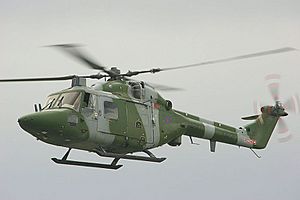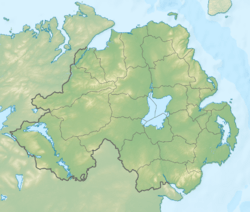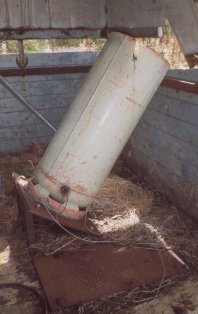1994 British Army Lynx shootdown facts for kids
Quick facts for kids 1994 British Army Lynx shootdown |
|
|---|---|
| Part of the Troubles | |

A British Army Lynx helicopter
|
|
| Location | Crossmaglen, County Armagh, Northern Ireland |
| Coordinates | 54°4′33.5″N 6°36′32″W / 54.075972°N 6.60889°W |
| Date | 19 March 1994 20:27 (GMT) |
| Target | British Army base |
|
Attack type
|
Mortar |
|
Non-fatal injuries
|
4 |
| Perpetrator | Provisional IRA |
On March 19, 1994, a British Army helicopter called a Lynx was hit and brought down by a group known as the IRA in Northern Ireland. A part of the IRA, called the South Armagh Brigade, fired a large homemade bomb (a mortar) at a British Army base. This happened in Crossmaglen, County Armagh. The mortar hit the helicopter, which was hovering above its landing spot. Its serial number was ZD275, and it crashed. Three British soldiers and one police officer were hurt in the incident.
Contents
What Happened Before
Since the 1970s, the IRA had been making their own special bombs called "mortars." They wanted weapons that could be fired from a safe distance. These weapons were also easy to hide. The IRA developed a mortar called the Mark 10. This led them to think about using these bombs to hit helicopters. They wanted to hit helicopters as they hovered over army bases near the border.
Early Attempts to Hit Helicopters
On June 22, 1983, the IRA tried to shoot down a Wessex helicopter. This happened over Crossmaglen, County Armagh. They used several Mark 10 mortars. The pilot had to quickly move the helicopter to avoid being hit. This caused the helicopter to drop its cargo onto the street. Four of the bombs did not explode. The others landed near the base, causing some damage. One British soldier was slightly hurt. Later, an investigation showed that if the bomb's base had been aimed slightly differently, it likely would have hit the helicopter.
The "Barrack Buster" Mortar
The homemade mortar designs changed over time. By 1992, they created the Mark 15 mortar. This bomb became widely known as the "barrack buster." This mortar shell was a metal cylinder, about one meter long. It was 36 centimeters wide and held about 70 kilograms of homemade explosives. It could be fired from 75 to 275 meters away. The cylinder was actually a gas cylinder used for heating and cooking in homes.
The first time the "barrack buster" was used was on December 7, 1992. It was fired at a police and army base in Ballygawley, County Tyrone. On June 11, 1993, the IRA tried again to hit a helicopter. They aimed a Mark 15 mortar at a Puma helicopter taking off from the Crossmaglen base. The barrack buster was fired from a baker's delivery van. It exploded on the helicopter's landing pad. Luckily, the pilot had just managed to take off. Two Lynx helicopters were flying with the Puma. They could not stop the attack. The IRA did this attack during a visit by Queen Elizabeth to Northern Ireland.
The Helicopter Attack
On the evening of March 19, 1994, a Lynx helicopter was landing. It was landing at the large British Army base in Crossmaglen. At the same time, an IRA group had put a Mark 15 mortar on a tractor. They hid the tractor behind bales of hay. The tractor was parked about 150 meters from where they wanted to hit. This was on an empty piece of land.
At 8:27 PM, the lights suddenly went out in Crossmaglen's town square. At the same moment, a single mortar bomb was fired into the army base. The IRA had used the town's electricity to help fire the bomb. This turned off the street lights. It also allowed the bomb's own battery to launch it.
When the Lynx helicopter was hovering about 30 meters over its landing spot, the mortar hit it. The bomb struck the helicopter's tail. The tail broke off from the main body. The helicopter spun out of control. But the pilot was able to crash-land the Lynx inside the base. A group of soldiers saw a huge orange fireball from a mile away. Three crew members got out with only small injuries. However, a police officer was stuck inside the burning helicopter. The officer was rescued just before the fuel tanks and ammunition started to explode.
A writer named Toby Harnden said this was the most successful IRA attack against a helicopter. It happened during a time known as the Troubles.
What Happened After
After the attack, the IRA and Sinn Féin were criticized. A local politician named Seamus Mallon spoke out. He said that many people could have been killed. He pointed out that the bomb was fired over houses. This showed how dangerous it was for so many people. He also said that Sinn Féin talked about peace but the IRA carried out violent attacks.
John Fee, another local politician, called the attack "crazy." Later, three men attacked him outside his home. One of them wore a hood and military-style clothes. The IRA said they were not responsible for this attack. Mr. Fee was taken to the hospital. He had broken legs, broken ribs, and head injuries.
Two soldiers were honored for their brave actions during the attack. Corporal Robert Tomlinson of the Royal Military Police helped the injured police officer. He also helped get the officer to medical care. He received an award called the Queen's Commendation for Valuable Service. Corporal Wayne Cuckson of the Royal Logistic Corps pulled the injured police officer out of the crashed helicopter. He received the Queen's Gallantry Medal for his bravery.
Another Helicopter Attack
There was a second mortar attack on a British military helicopter on July 12, 1994. This happened in Newtownhamilton. An RAF Puma helicopter was carrying 11 soldiers and one police officer. It crash-landed on a soccer field. Its tail was hit by pieces from another Mark 15 mortar. This bomb was also launched from a tractor. The helicopter was taking off from the local army base. No one was seriously hurt. The Puma helicopter was badly damaged. After being repaired, it crashed again in Germany in 1997 and was taken out of service.
These two helicopter attacks, along with more sniper attacks by the IRA, were a big problem for the British forces. They affected both their spirits and their military plans in south County Armagh.
See also
- Chronology of Provisional Irish Republican Army actions (1990–99)
- List of attacks on British aircraft during The Troubles
- Improvised tactical vehicles of the Provisional IRA



